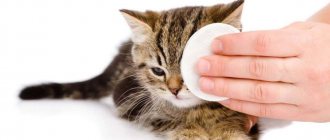When stroking a pet, you feel that its body temperature is higher than that of a person. Exceeding a few degrees is considered normal. The average indicator covers parameters from 38 °C to 39 °C. An increase or decrease will signal the beginning of the development of inflammatory processes in the animal’s body. It is useful for owners to know what signs of pathological changes appear. It is recommended to be aware of what to do at home if your cat has a fever.
Normal temperature in cats
In a healthy animal, body temperature during the day can vary from 37.4 °C to 39.5 °C. The exact indicators are individual for each pet, in addition, they are influenced by the characteristics of the breed. Owners should know the normal indicators for their cat in order to detect changes in a timely manner.
An elevated temperature in a domestic cat should alert any owner
For your information! For an adult porridge, an indicator of 39.4 °C will not cause any complications. But for a kitten this is a very serious symptom.
During the day the values will change:
- during sleep and early in the morning they are low;
- increased after physical activity, meals and in the evening.
Particular attention should be paid to small kittens. Their process of independent thermoregulation develops gradually. Therefore, the norm indicators for them will be different. Newborn kittens feel good in the range from 35.6 °C to 36.6 °C. Only at the age of 3-4 months do they reach adult parameters.
With age, metabolic processes in animals slow down just like in humans. Therefore, the body temperature will be below average. In pregnant females, on the contrary, the indicators increase.
Important! Cats with a small coat of fur will feel much hotter to the touch, since the distance between the palm and the animal's body is small.
Normal temperature readings in animals
How to help a cat with a high temperature
Treatment methods for a cat with a high fever depend on the diagnosis and the extent of the disease. Since a high temperature can be a sign of a disease, the main treatment is aimed at eliminating the inflammatory focus in the body. Most often, when antibiotics are prescribed, the body temperature returns to normal.
In general, high temperature in itself is not dangerous. After all, with its help, the animal’s body tries to fight the virus on its own. Reducing the temperature with the help of antipyretic drugs is necessary in case of very high temperatures, which can provoke convulsions in the animal.
If the temperature is not very high, then you can try to bring it down at home. To do this, you need to moisten a towel or gauze with cold water and wrap the animal for about ten minutes. As the fabric dries, the cat's body temperature will noticeably decrease. Such manipulations are very effective in increasing body temperature from overheating of a pet outside in hot weather.
The same quick effect can be achieved by using ice from the refrigerator. Wrap the pieces of ice in gauze and place them on the cat's neck and inner thighs. In this case, you should give her something to drink more often. To prevent dehydration, it is recommended to give your pet pharmaceutical rehydron.
Only a specialist can prescribe comprehensive treatment for a cat after a thorough examination. If the temperature does not decrease even after taking antibiotics, the doctor will prescribe an additional study to identify the causes of hyperthermia.
It should be noted that a low temperature in an animal also indicates an existing pathology in the body. The cause of low temperature may be blood loss or hypothermia. Sometimes this temperature is observed in cats with chronic diseases of the kidneys and endocrine system. Help in these cases is to warm the pet using a warm heating pad. If your cat's body temperature persists for a long time, you should consult a specialist.
Since high temperature is a consequence of a disease, preventive measures are aimed at avoiding them by observing hygiene standards, rational nutrition and proper care of the animal.
An elevated temperature in a cat can be a sign of a disease, stress or overheating. This symptom can be a sign of various diseases. Before resorting to any global measures, the temperature should be brought down, but done correctly.
Attention:
The normal body temperature of a cat and a human is significantly different. Optimal and healthy indicators for cats range from 38.5 to 39.5 degrees.
A slight increase in body temperature does not actually affect the general condition of the cat, as well as its daily behavior.
Often, such an ailment goes away on its own and does not require any adjustments from the owner. It's another matter when the degrees begin to skyrocket. The first signs of oppression can be observed already at a temperature of 40 degrees.
The symptoms look like this:
- lack of appetite;
- lethargy;
- drowsiness (the cat sleeps constantly);
- apathy;
- tremor;
- cardiopalmus.
Some owners determine if their pet has a high fever by feeling the nose for signs of moisture. However, this method is completely ineffective.
For example, cats' noses dry out only in the presence of very high temperatures. Also, during the sleep process, the nasal epithelium also remains dry.
Attention:
Sphynx cats have a normal body temperature of 41-42 degrees. This is due to the individual characteristics of the body of these animals and the lack of the usual coat.
Symptoms of fever in a cat
Constipation in a cat: what to do at home
The pet will feel unwell at both low and high temperatures. An attentive owner will always notice that something is wrong with the pet; the cat has a high temperature. External signs may include:
- lethargic appearance;
- rapid pulse, the pet begins to breathe heavily;
- The cat's nose is dry and hot.
Note! Veterinarians recommend that pet owners monitor their cat’s temperature for several days in a row. This is necessary to recognize it in normal condition.
If an animal has a low temperature, the condition will manifest itself with the following signs:
- trembling, the pet will freeze;
- manifestation of apathy and lethargy;
- pallor on the mucous membranes;
- cold stomach
The cat will look for a warmer place and bury itself under the blanket. If an animal exhibits uncharacteristic signs of behavior, it is necessary to measure the indicators.
Signs of fever
How to measure a cat's temperature
The procedure for measuring body temperature is not pleasant, both for the owner and for the pet.
Before starting the procedure, it is necessary to catch the animal and neutralize it. The best way to do this is by “swaddling” the cat in a towel or blanket. You should not hope that Murka, who is calm in everyday life, will behave adequately in this difficult situation.
In addition to neutralizing the clawed paws, it is necessary to hold the biting head so that the cat cannot take revenge on the offender. It is best to carry out the procedure with the help of a patient assistant.
The thermometer must be lubricated with Vaseline before the procedure and disinfected with alcohol after completion.
The tip of the thermometer must be placed 2 centimeters into the rectum. The procedure takes about three minutes. It is important to prevent the animal from making sudden movements at this time. It is best to speak to her in a calm tone and not show excitement.
After completing the procedure, you need to hide the thermometer from the frightened animal and make amends with tasty encouragement, so that the mug does not harbor a grudge against the owner.
There is also a less painful way to measure body temperature. An infrared ear thermometer allows you to take readings painlessly and without ruining your relationship with your pet. However, this method is not suitable if the animal has an inflammatory process in the ears. Then the thermometer will show an incorrect result.
It must be remembered that you should not measure a cat’s temperature over trifles. A common misconception is that if a cat has a dry, hot nose, then she is definitely sick. However, in practice, cats can “dry out” their nose in their sleep. Therefore, you should not disturb the rest of a healthy cat with such troubles as measuring body temperature.
What to do if your cat has a temperature: rules for measuring it
Diarrhea and vomiting in a cat: what to do at home
Several types of thermometers can be used. If a contact device is selected, it must be individual for the animal.
Important! You need to use a mercury thermometer very carefully, as it can easily break.
Owners of active pets should pay attention to the following types of devices:
- electronic tonometers of universal type. The measurement result is available within a few minutes;
- rectal electronic ones provide readings in 10 seconds;
- infrared ear - a device programmed for a measurement cycle.
All tonometers, except the ear one, are intended for rectal use. It is important that the owner behaves calmly and does not raise his voice at the pet.
The procedure should be carried out as follows:
- Measurements must be taken on a table; doing so on your hands is dangerous.
- The tip of the device must be wiped with alcohol, then lubricated with Vaseline. The cream cannot be used, as it contains perfume fragrances.
- The readings on the tonometer should be at 35 °C before starting the measurement.
- The cat needs to be laid on its side and its paws wrapped.
- The tip is inserted with rotational movements into the anus.
Important! The measurement result will be incorrect if the cat was constantly moving during the measurement.
Measurement Rules
Why does the temperature rise
Urinary incontinence in a cat: what to do at home
An animal's temperature may increase both due to the development of pathology and due to a physiological process. The reasons may be:
- the occurrence of viral diseases such as plague, coronavirus, rhinotracheitis;
- development of inflammation due to infection of wounds and sutures after operations;
- overheating of the body. This phenomenon is typical for small kittens and weak animals. Most often, the temperature can increase if you stay in a stuffy room for a long time;
- nervous stress, overexertion, for example, moving, sterilization.
For your information! Often, pets' temperature rises by one degree after vaccination.
Overheating as a cause of temperature rise
Normal temperature
Normally, the temperature in cats is much higher than the physiological indicator in humans. Purring predators always seem warm to us. This is due to higher rates of natural heating of the skin and muscles of animals.
Thermometer readings in the range of +38.0... + 39.0°C are considered normal for adult domestic cats. In kittens, higher values are often noted: up to +39.5°C.
A deviation from the physiological norm of at least 2-2.5°C upward or downward indicates health problems.
But deviations can also be observed in the physiologically normal range. If a caring owner tries to determine the temperature of an adult animal, he will find that it:
- increases after increased activity and vigorous games;
- depends on gender (in cats it is often slightly higher);
- varies depending on the pet’s age (the older, the lower);
- in the evening it is often higher than in the morning;
- may be higher in extreme heat.
Such changes rarely go beyond the average range of normal physiological values, or go beyond the extreme values by 0.5-1°C.
First aid at home before the doctor arrives
If the temperature increases slightly, there is no need to bring them down. The body must fight inflammation on its own. An increase indicates that protective mechanisms have come into play. It is necessary to take action if the value reaches 40-40.5 °C. You need to call a doctor and provide first aid to the animal. What to do at home if your kitten has a fever:
- humidify the air in the room where the animal is located;
- give your pet cool water;
- wrap in a wet towel;
- put cold behind the ears and on the neck.
Important! Treating an animal with drugs that are used to reduce fever in humans is unacceptable, as this can cause allergies or impaired kidney function.
First aid at home
Medications
It is strictly forbidden to self-medicate in order to bring down a cat’s high fever. Ignoring the situation may lead to seizures.
Drugs can only be prescribed by a veterinarian after a complete diagnosis. Treatment should be aimed at eliminating the cause, and antipyretic tablets are given as part of complex therapy.
If the temperature reaches 40.5-41 °C, the cat is given a quarter of an analgin tablet. In case of pronounced chills and trembling of the body, the veterinarian makes intramuscular injections and injects drugs into the anus using an enema.
In especially severe cases, a mixture of analgin and diphenhydramine is prescribed per 1 kg of the cat’s weight. This is an undesirable measure; it is used only in extreme cases when it is necessary to urgently reduce performance.
Medication methods are applicable only after consultation with a doctor
Causes of fever in a pet
The dynamics of indicators that characterize a cat’s temperature is one of the most important signs of the presence or absence of any disease.
Some owners of furry pets, when they detect a high temperature based on external signs, panic because they have no idea how to measure it correctly. In principle, measuring the temperature of cats is not particularly difficult, since it is carried out with well-known medical devices, in particular a thermometer.
Ideally, you need to have an individual device for your pet, which is best stored in a special “cat first aid kit.” For measurements, you can use either a regular mercury thermometer or a more advanced type - an electronic thermometer.
Of course, an electronic device has a number of advantages. With its help, it is much more convenient and faster to perform the procedure, and the result indicators are highly accurate. However, in the absence of a universal device, a regular mercury thermometer is quite suitable. Before the procedure, it is important to treat it with any disinfectant solution. The same should be done after measuring the temperature.
You can accurately measure a cat's body temperature in the rectum, while securing the pet with a towel. This is done so that the animal does not move during the procedure, since the accuracy of the measurements is guaranteed only if the animal behaves calmly.
Before the procedure, the tip of the thermometer is lubricated with baby or any other fatty cream. Carefully lifting the pet's tail, lightly insert the tip of the thermometer into the anus to a depth of one or two centimeters. In just two or three minutes you can take out the device and see the result.
The easiest way to measure the temperature is if the cat is in a standing position. But it is possible to carry out this procedure even in the case of a lying position, when the animal is very weak due to illness. The cat is greatly influenced by the emotional state of the owner, so this procedure must be performed without unnecessary fuss.
Traditional methods
You can reduce your temperature using simple folk methods. To make the assistance as effective as possible, it is recommended:
- place the animal in a cool room, open all windows and doors to ensure sufficient air flow;
- Moisten the wool a little with water or wrap the body with a wet cloth. But it is important to prevent hypothermia;
- Apply a cold compress to the neck and behind the ears. As soon as the fabric heats up, it is changed;
- Be sure to give your pet plenty of cool water. If he refuses to take the liquid, it is infused with a syringe;
- Every hour, lubricate the pads on the paws with an alcohol solution diluted 1:3 with water. A vinegar solution is also suitable for wiping.
If a kitten has a fever, no one usually knows what to do. Alternatively, you can use herbal infusions. For example, echinacea tincture has a good effect. It kills the virus and prevents the development of infection.
To obtain a solution, the tincture is diluted with water at the rate of 1 drop per day per 1 kg of animal weight. The solution is injected using a syringe. If the temperature does not decrease within 24 hours, it is necessary to show your pet to a doctor.
Echinacea as a remedy for fever
How dangerous is a fever in an animal?
High temperatures pose a huge danger to cats. Exposure to temperatures above 40-41 degrees for several days leads to irreversible processes in the body. The pet becomes dehydrated, swelling of the brain and disruption of the functioning of a number of internal organs may occur.
So, first you need to not panic. Try to remember how your cat behaved over the past few days, what it ate and whether it was outside or in contact with other animals or strangers.
If the animal’s condition is not critical, namely, the pet does not refuse food and water, but prefers to sleep most of the time, monitor it for exactly 24 hours. If within 24 hours the condition remains the same or worsens, then go to the doctor.
Massage and diet
During periods of high fever, the animal must be fed only dietary food. You cannot overfeed or force it. The main thing is that the cat drinks as much water as possible.
Note! Food should only be liquid, for example, you can offer your pet low-fat chicken broth.
Vitamin C must be added to the diet to improve immunity. It helps the body fight inflammation. During illness, you can give your cat a mixture of yogurt, ascorbic acid and cottage cheese. Adults are given up to 500 mg of ascorbic acid per day.
Massage has a positive effect on reducing temperature. You need to knead the point under the knee bend on the outside of the hind leg for two minutes. Then you can lightly massage your entire body. The main objective of the procedure is to enhance blood activation. This will help speed up the healing process.
Massage to reduce temperature
When to contact a veterinarian
Cats have two borderline conditions in which it is important to immediately take emergency measures. Temperatures above 40.5 °C, accompanied by severe fever, can be fatal. If your pet is breathing frequently and showing signs of tachycardia, this can lead to:
- hemorrhages on the skin;
- severe diarrhea;
- internal bleeding;
- cerebral edema;
- profuse vomiting with dehydration.
Important! It should not be neglected if an elevated temperature is observed for three days. The animal should be taken to the veterinarian even if there are no additional symptoms.
If the increase progresses, the animal will require resuscitation measures that cannot be carried out at home.
Contacting a veterinarian
The cat has a temperature of 40-41 °C - what to do?
A cat’s body temperature, which stays between 40-41 degrees, is critical, as it provokes severe loss of fluid, swelling of the respiratory tract, as well as the brain.
This condition of the pet requires immediate medical attention.
However, first you should try to reduce the temperature at least a little:
- Place an ice pack on your cat's inner thigh.
- Wet your animal's paws and belly with cool water.
- The cat must be force-fed cool water in small portions.
You should not give any antipyretics to your cat, even if they are intended for children. Medicines with excessively high thermometer readings can lead to the most unpleasant consequences and even the death of a pet.
Prevention
Knowing the reasons why a cat’s temperature may rise, you can take preventive measures to avoid the development of complications. To minimize inflammatory processes and various pathologies, it is recommended to observe the following measures:
- maintain a proper diet. Animals should receive adequate nutrition, enriched with vitamins and minerals;
- regular vaccinations according to schedules;
- It is important to avoid overheating, prolonged exposure of the animal in a car, a stuffy room, or on a windowsill in the sun.
It is important for pet owners not to ignore the warning signs of fever. You cannot self-medicate, since first of all it is necessary to establish the reasons for the increase in indicators. To avoid the development of complications, when you notice the first signs of poor health in your pet, you need to take him to the veterinarian.











